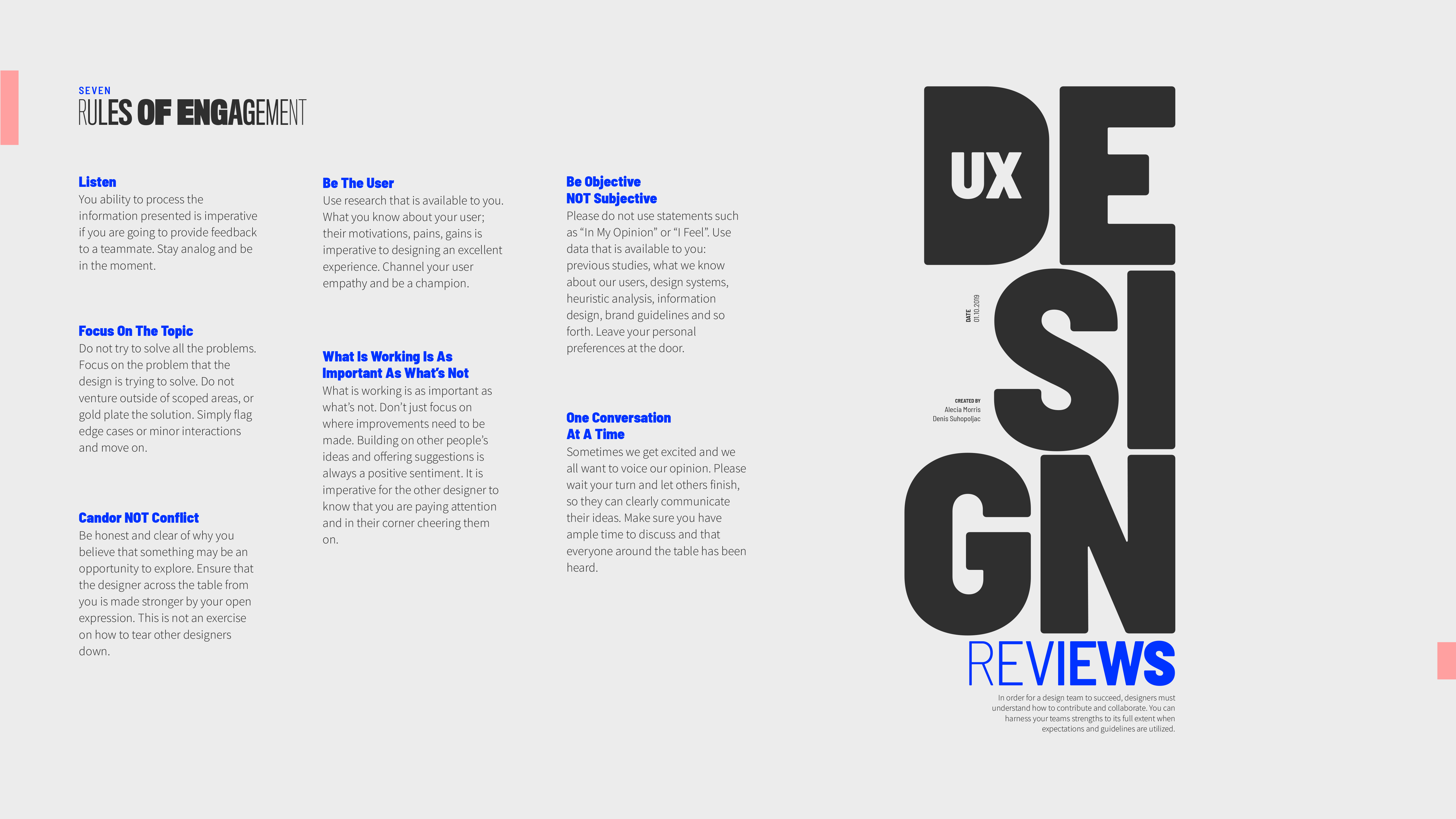↓ Design Reviews
Guidelines & Documentation
A design team has to understand how they can contribute and in which ways they can collaborate. When a team has clear expectations and set guidelines it can utilize all of its skillsets to get the best outcome.
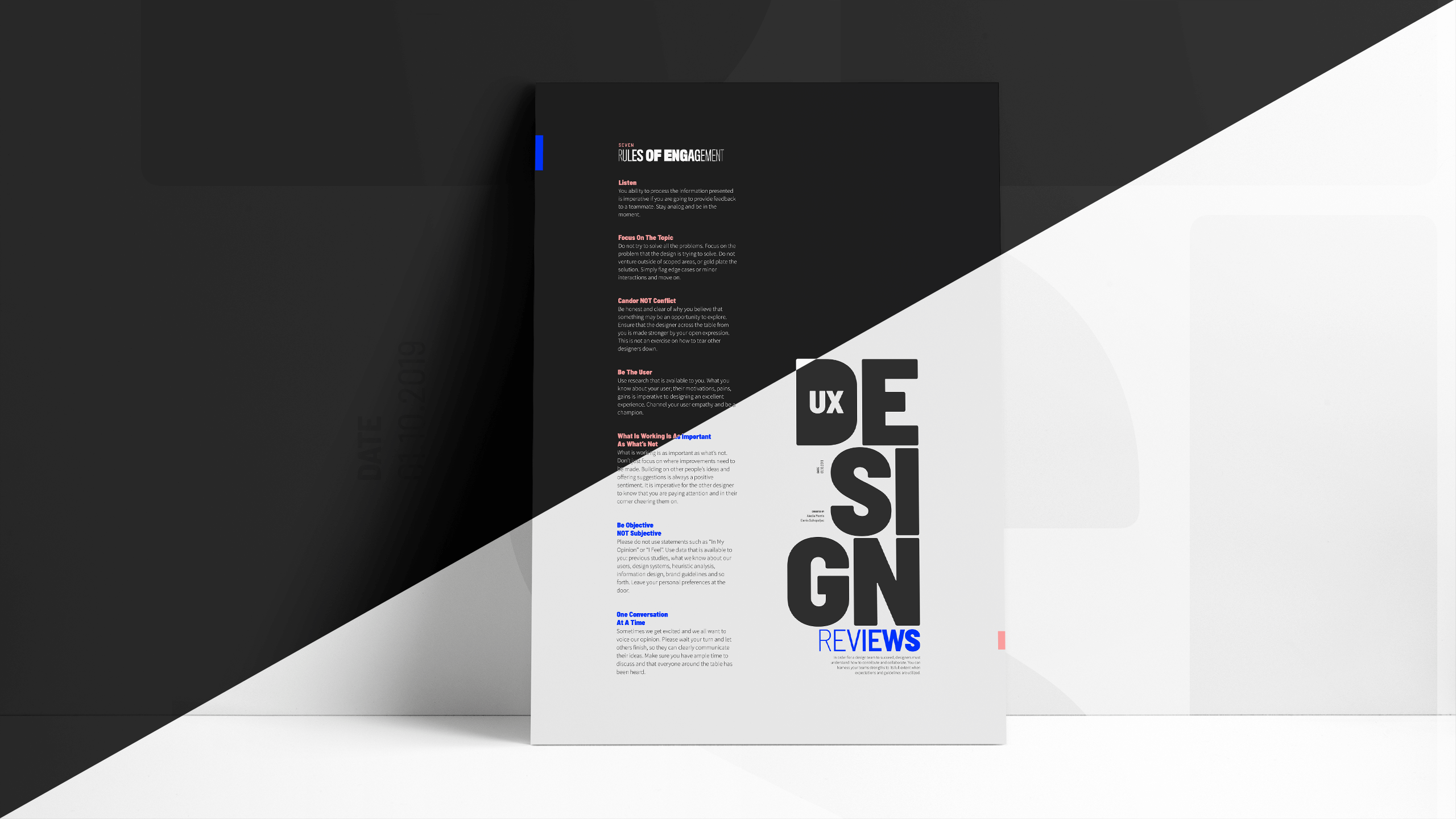
Embracing design reviews and improving collaboration on design teams
A design team has to understand how they can contribute and in which ways they can collaborate. When a team has clear expectations and set guidelines it can utilize all of its skillsets to get the best outcome.
In order for a design team to succeed, designers must learn how to work together. A lot of factors can get in the way of this, including tight deadlines or competing priorities when embedded in separate production teams. The result can be a team of individuals that tend to work in isolation and don’t collaborate. When you ignore this early symptom of a dysfunctional team, it is extremely difficult to change the “me and myself” culture down the road. It also puts you at risk of having single points of failure when a single designer holds all the knowledge and designs for a particular area.
You can harness your teams strengths to its full extent. As design leaders, we are responsible for this ideal outcome. It is our responsibility to create a safe space for collaboration and knowledge sharing.
We are going to share a process that has proven to be a great way of sharing our knowledge and helping each other expand our skills in the product design team at Unbounce. We continue to evaluate and fine tune this process as we evolve.
Whether your team has recently formed or you have had the same team for awhile this guide should help you create the foundation of a collaborative design culture.
Creators
Denis Suhopoljac
Alecia Morris
↓ Resources
Design Review Poster
Dark Desktop Wallpaper
Light Desktop Wallpaper

Pictured left to right: Yosem Sweet, Paul Doerfling, Paul Kalupnieks, Ricky Knight, Johnny Opao, Bryan Holt, Alecia Morris, Sarah Gillis.
"It is imperative to seek feedback often and early. Do not wait until you are stressed and under the gun of a deadline. When you seek design feedback you have to be willing and open to hear it."
Design Rules of Engagement
In the same sense that IDEO uses its brainstorming rules and encourages participants to go for volume, these rules should inherently encourage designers to see possibilities. The whole point of a design review is to uncover potential for ideation, not to get approval or affirmation.
It is imperative to seek feedback often and early. Do not wait until you are stressed and under the gun of a deadline. When you seek design feedback you have to be willing and open to hear it.
These 7 rules should help you ensure that you get the best possible outcome every-time you facilitate a design review.
1. Listen
Your ability to process the information presented is imperative to providing feedback to a teammate. Ideally you want to use a notebook and remove yourself from distractions of digital devices. Our encouragement is to stay analog unless you are presenting.
2. Focus On The Topic
Do not try to solve all the problems. Focus on the problem that the design is trying to solve. Do not venture outside of scoped areas, or gold plate the solution. Try and avoid spending too much time on edge cases or minor interactions that can be resolved with fine tuning or through usability testing. Simply flag it and move on.
3. Candor NOT Conflict
Candor is defined as “The quality of being open and honest in expression; frankness.” while Conflict is defined as “A serious disagreement or argument, typically a protracted one.”
That means you are being honest and clear of why you believe that something may be an opportunity to explore. You may have information in the form of research, strategy, technology etc. that would help improve the experience. Ensure that the designer across the table from you is made stronger by your open and honest expression. This is not an exercise to tear other designers down or stroke your own ego.
4. Be The User
This is just a simple reminder to use research that is available to you. What you know about your user; their motivations, pains, gains is imperative to designing an excellent experience. Channel your user empathy and be a champion.
5. What Is Working Is Important As What's Not
Remember to highlight the elements that are working with this particular design solution. If something is really awesome vocalize and communicate it. Don’t just focus on where improvements need to be made. It is imperative for the other designer to know that you are paying attention and in their corner cheering them on.
6. Be Objective NOT Subjective
This one is self explanatory. However, I will reiterate. Please do not use statements such as “In My Opinion” or “I Feel”. Use proven methods to communicate your feedback. Use data that is available to you: previous studies, what we know about our users, design systems, heuristic analysis, information design, brand guidelines and so forth. Leave your personal preferences at the door.
7. One Conversation At A Time
Sometimes we get excited and we all want to voice our opinion. Please wait your turn and let others finish, so they can clearly communicate their ideas. Make sure you have ample time to discuss and that everyone around the table has been heard.
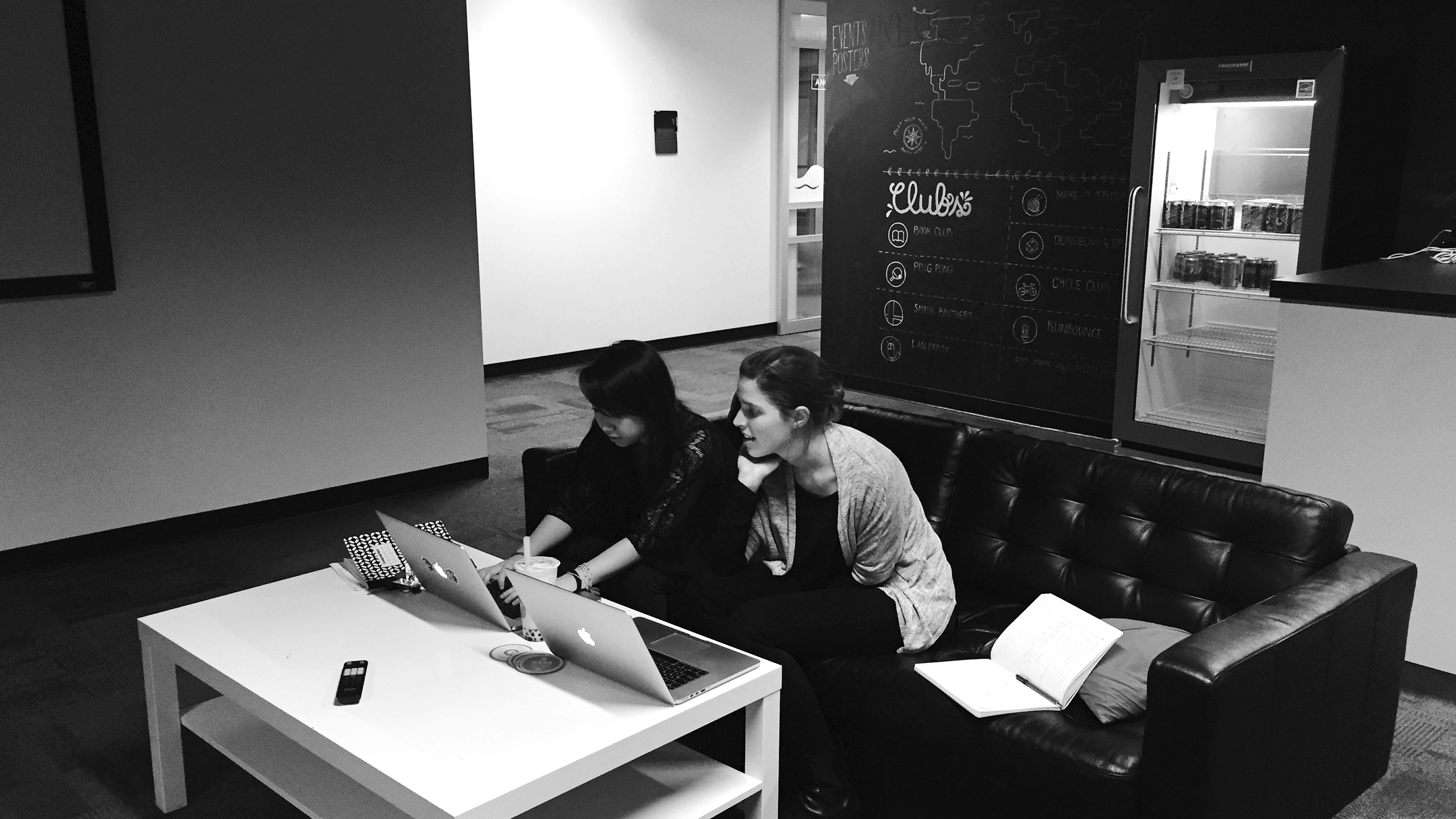
Pictured left to right: Denise Villanueva, Sarah Gillis
"In the same sense that IDEO uses its brainstorming rules and encourages participants to go for volume, these rules should inherently encourage designers to see possibilities."
Preparation for your Design Review
Sometimes you are able to send out your designs ahead of time. However if your designs are not self explanatory, they may cause more confusion than good sending them ahead of time.
1. Set Your Goals
Create a list of goals you want to achieve during the review session. Share your goals at the beginning of the design review session with the rest of the group.
2. Set The Stage
☐ Be clear what areas of the design are or are not ready for feedback.
Example: If you don’t want feedback on visual design yet, then be up front with the team that it is not ready for review and not to focus on that aspect yet.
☐ Share the details with the group:
- Who is going to be using it?
- What will they be trying to do?
- Where will the design be used?
☐ Be prepared to explain the design rationale as you walk through your design.
This helps arm people with the knowledge of why the design is the way it is. What people see is really just the tip of the design iceberg and it’s important to make a lot of that design thinking below the surface a bit more visible.
☐ Decide if you want to do printouts posted to the wall or display on the big screen.
Sometimes there is a strong benefit with the analog approach. It inherently encourages team bonding while you all shuffle for space and make notes.
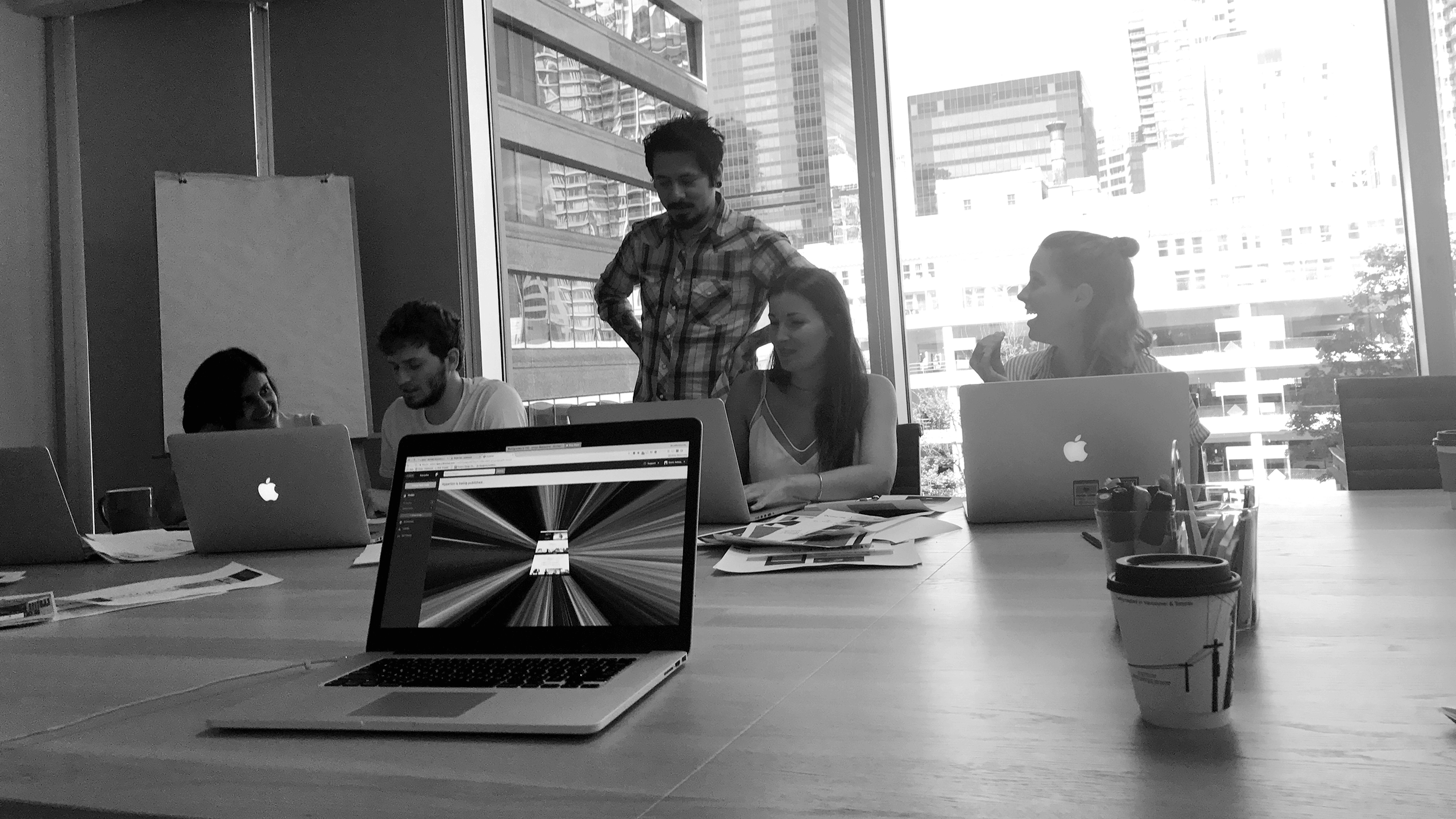
Pictured left to right: Himali Tadwalkar, Luis Francisco, Cesar Martinez, Rebecca Preston, Sarah Gillis
During your Design Review
The expectation is that the person that is facilitating the design review is also ensuring that the session is flowing accordingly. As a design review facilitator you should walk away from the session with clear notes, next steps and plenty of opportunity.
1. Take Notes
☐ What participants felt worked well.
☐ What participants felt didn't work well.
☐ Include any ideas and solutions raised during the session.
☐ Any parking lot items.
☐ Any decisions that affect the component library, design patterns or interaction guidelines.
2. Rules Of Engagement
☐ Ensure that all participants follow and abide by set rules.
You may be comfortable with this responsibility or you may appoint a moderator of your choosing.
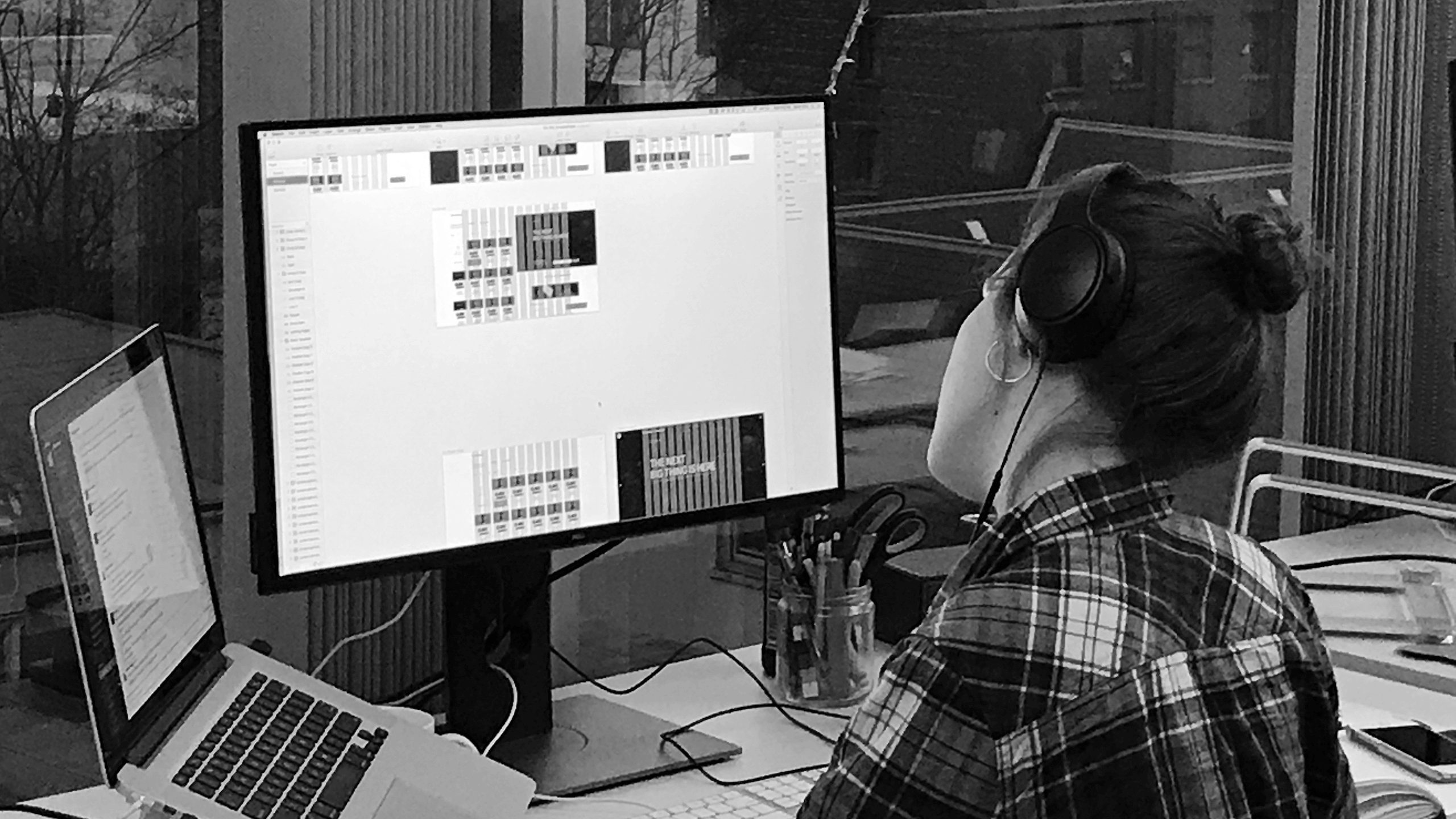
Pictured: Sarah Gillis
After for your Design Review
Ensure to allocate some time to work through the next iteration of your design. Ideally you should engage designers on the team to work through any challenges or opportunities highlighted in the design review.
1. Solve for what didn't work well
Feel free to engage team members to help in solving challenges identified in the session. It’s probably better to pair with another designer and invite a lead/principal designer as a second collaborator.
2. Share revised designs
You can do this by either print your new designs out and share them with the rest of the team. You may have a slack room designated for design reviews. You could schedule a second Design Review session if you feel it is needed.
3. Follow-Up on any Parking Lot Items
4. Update or Add components to the design system, design patterns or interaction guidelines discussed during the design review
The Resources
Early in our careers we often worked in environments that were all about competition. All of our energy went towards winning and being the best. This competitive nature only fostered and rewarded individuals trying to outdo each other instead of support and learn from each other.
This guide should help you create the foundation block of a collaborative design culture. It will facilitate better design reviews and find ways to build a stronger connection among team members.
We have created our Design Rules of Engagement poster. Feel free to download, print it and use it in your space.
→ Download Poster / 11x17. Vector. Scalable for large prints. Portrait and Landscape. Dark and Light versions available.
→ Download Dark Wallpaper / 5K Resolution. 5120x2280.
→ Download Light Wallpaper / 5K Resolution. 5120x2280.


